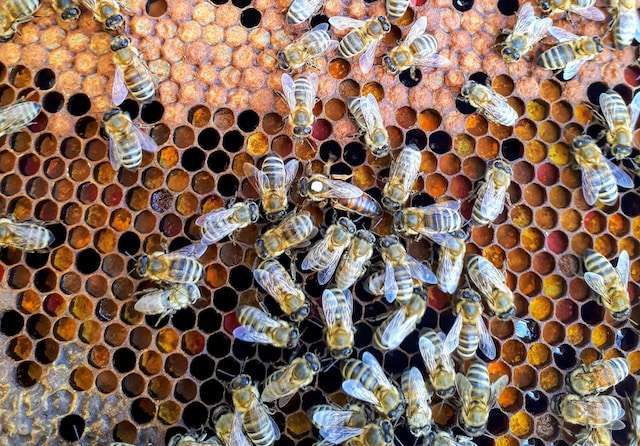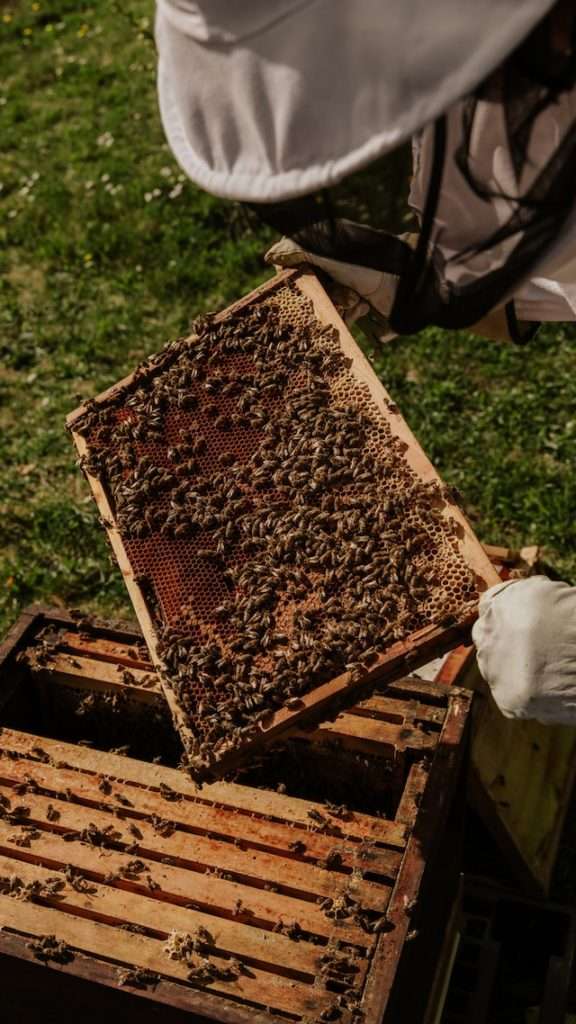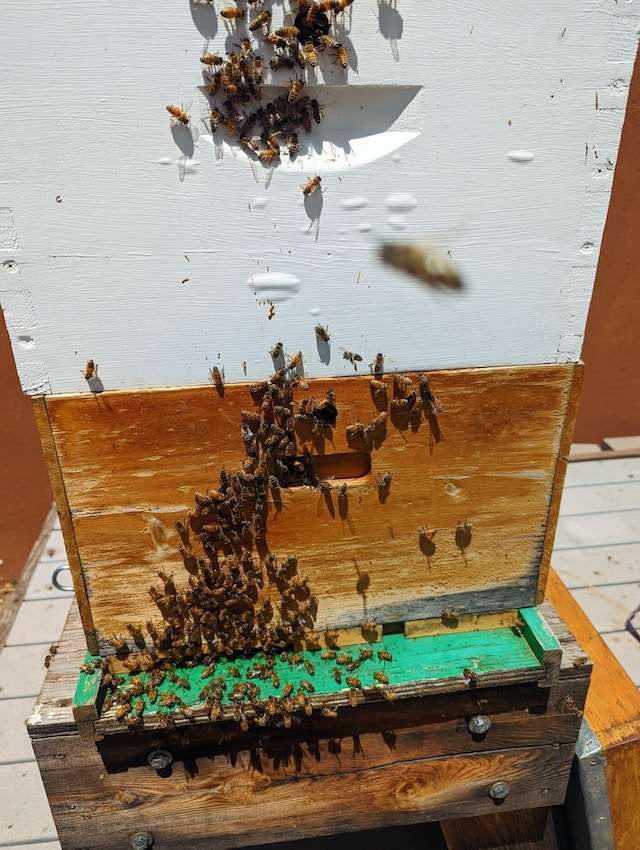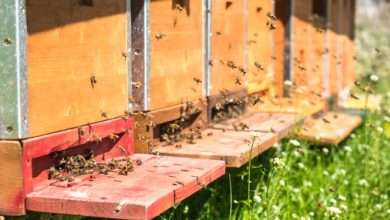The Drone Bee: Unlocking the Secret to a Thriving Hive Population

Have you been captivated by the amazing activities of well-organized beehives? Have you been wondering what makes the hives so full of life and productivity? The answer is drone bees – an essential part of the hive and the key to a thriving population.
This article takes a deeper look at drone bees, helping you understand why they play such an important role and what this means for beehive populations as a whole. We’ll explore the science behind the drones and the role they play in hive functioning.
Shedding Light on the Role of Drone Bees in a Beehive
Drone bees, unlike their female counterparts, do not engage in typical hive tasks such as collecting pollen or nectar, nor do they participate in building and cleaning the hive. Instead, their primary responsibility lies in mating with the queen. Drones are male bees, and their sole purpose is to fertilize the queen during mating flights, thereby ensuring the reproduction and continuation of the colony.
Significance for a Healthy Hive Population
- Genetic Diversity: One crucial role played by drone bees is the promotion of genetic diversity within the beehive. The process of mating allows for the mixing of genetic material from different bees, which is essential for the overall survival and adaptability of the colony. By introducing genetic variation, drone bees contribute to the resilience of the hive, enabling it to better face environmental challenges and resist diseases.
- Maintaining Hive Balance: Although drones do not actively engage in other hive chores, their presence is necessary for maintaining a stable social structure within the colony. The ratio of drones to workers and queen bees is crucial to keep the hive in equilibrium. A balanced hive population ensures that all tasks in the beehive are carried out efficiently, promoting a healthy and productive environment.
- Seasonal Adjustments: Drone bees also play a vital role in seasonal adjustments within the colony. During specific times of the year when nectar and pollen are scarce, drone production decreases significantly. This reduction in drone population helps conserve resources, allowing the hive to allocate its limited resources more effectively towards tasks that are critical for its survival, such as storing honey and caring for the queen and larvae.
- Mating and Reproduction: The successful mating of drone bees with the queen is crucial for the reproduction and growth of the colony. Each drone carries genetic material that can potentially contribute to the resilience and adaptability of future generations. This genetic exchange not only ensures the hive’s survival but also enables it to thrive and evolve in changing environments.
What are Drone Bees?
Drone bees are an integral part of the honeybee colony, playing a specific role within the social structure of a beehive. Unlike the female worker bees responsible for tasks such as foraging, nursing the young, and maintaining the hive, drone bees are male counterparts with their own unique characteristics.
Physically Different from Worker Bees
One striking feature that sets drone bees apart from worker bees is their larger size. They are noticeably bigger, measuring around 15-17 millimeters in length, compared to the usual 13-15 millimeters of female worker bees. This size difference is not limited to their length but can also be observed in their broader abdomen. Moreover, drone bees have larger eyes, enabling them to detect potential queen mates during their mating flights.
Additionally, drone bees are often mistaken for queen bees due to their appearance. While both exhibit a similar body shape, drone bees can be differentiated by their larger, rounder thorax, as well as antennae that are noticeably longer than those of queen bees.
Their Place within Beehive Social Structure
The social structure of a beehive is complex and organized, with each member having specific roles and responsibilities. Within this intricate system, drone bees hold a unique position. Their primary function is not to gather nectar or pollen, nor do they participate in hive maintenance. Instead, drones play a crucial role in the reproductive aspects of the colony.

Drone bees are solely dedicated to mating with virgin queen bees. Their main purpose is to provide sperm for the queen to fertilize her eggs, ensuring the continuation of the honeybee colony. During the warm months of the year, drones venture out of the hive on mating flights in search of a mating congregation area known as a drone congregation area (DCA). Here, hundreds of drones from various colonies gather, emitting pheromones to attract virgin queens.
However, once drones have fulfilled their reproductive duty, their presence becomes less essential for the hive. As winter approaches, worker bees typically expel drones from the hive as they consume resources without contributing to the survival of the colony during colder months, when resources become scarce.
The Life Cycle of a Drone Bee
Here, we will delve into the stages of a drone bee’s development, their duration, and the distinctive characteristics they possess.
Stages of a Drone Bee’s Development
The life cycle of a drone bee consists of several distinct stages, showcasing their remarkable transformation from an egg to adulthood. Let’s explore each stage in detail:
1. Egg Stage:
- The development of a drone bee begins with the queen bee laying an unfertilized egg.
- These tiny, cylindrical eggs are laid within the honeycomb cells.
- They are smaller in size compared to worker bee eggs but larger than those of a queen bee.
2. Larval Stage:
- Following the egg stage, hatching takes place, and the drone bee enters the larval stage.
- Larvae are cared for and fed by the worker bees in the hive.
- They are distinguishable by their plump, elongated bodies and lack of wings.
- Larvae consume a special diet called royal jelly, consisting of pollen and nectar, for nourishment and growth.
3. Pupal Stage:
- After around six days as larvae, the drone bees enter the pupal stage.
- During this time, they undergo a remarkable transformation within sealed honeycomb cells.
- Pupae appear as white, cocoon-like individuals possessing legs, antennae, and developing wings.
4. Adult Stage:
- Finally, the dramatic emergence of adult drone bees occurs.
- Once they break free from their cells, drone bees are ready to embark on their roles within the colony.
- This stage marks the beginning of their short but significant adult life.
Duration of Each Development Stage
Understanding the time taken by drone bees to progress through each stage of their life cycle allows us to comprehend their overall lifespan and developmental patterns. Let’s explore the durations of the different stages:
1. Egg Stage:
- The egg stage typically lasts for approximately three days.
2. Larval Stage:
- After the eggs hatch, drone bee larvae spend around six days in this stage.
3. Pupal Stage:
- Following the larval stage, drone bees enter the pupal stage, which lasts for approximately 14 days.
- During this period, their body undergoes essential transformations and maturation.
4. Adult Stage:
- Once the pupal stage concludes, adult drone bees emerge from their cells and begin their adult lives.
- Unlike worker bees, drone bees do not experience an aging process, allowing them to live for about 90 days.
Unique Traits and Behaviors Exhibited by Drone Bees
As male members of a bee colony, drone bees exhibit several unique traits and behaviors. Let’s delve into some of these remarkable characteristics:
Large Size and Appearance:
- Drone bees are noticeably larger in size compared to worker bees.
- Their large, round bodies are characterized by broader heads, bigger eyes, and longer antennae.
- With stout and strong bodies, they are specifically suited for their reproductive roles.
Lack of Stingers:
- Unlike worker bees and queen bees, drone bees do not possess stingers.
- This distinctive trait allows drone bees to focus entirely on their reproductive responsibilities.
Mating and Reproduction:
- The primary purpose of drone bees is to mate with new queen bees from other colonies.
- During mating flights, drones pursue and compete for the opportunity to mate with a queen.
- After mating, their reproductive organs are severed, resulting in their eventual death.
The Purpose of Drone Bees
Now, we’ll explore the purpose of drone bees within the bee community, focusing on their reproductive role, mating behavior, and their contribution to the genetic diversity of the population.
- Reproductive Role of Drone Bees in the Hive:
Unlike the female worker bees, whose primary task is to collect nectar, build comb, and care for the young, drone bees have a singular purpose in the hive – reproduction. Drones are male honey bees who develop from unfertilized eggs laid by the queen. Their main function is to mate with the queen and contribute to the perpetuation of the species.
- Mating Behavior and Responsibilities of Drone Bees:
Mating for drone bees is a crucial and ephemeral process. When the time is right, usually during warm and clear weather, drones take flight in so-called drone congregation areas. These zones, often located at significant distances from the hive, serve as meeting points for drones from various colonies.
Once at the congregation area, drone bees engage in complex mating flights. During these aerial displays, the drones compete to mate with a receptive queen, who would have left her hive in search of a suitable partner. The drones’ unique anatomy allows them to mate only once, as their genitals are ripped off during the act. Consequently, the drone dies shortly after mating.
While a successful mating event grants the drone fulfillment of its reproductive role, it should be noted that not all drones are fortunate. In fact, most drones never have the opportunity to mate and contribute their genetic material to future generations, highlighting the competitive nature of honey bee mating.
- How Drones Contribute to Genetic Diversity Within the Bee Population:
The mating behavior of drone bees plays a critical role in maintaining genetic diversity within the bee population. The genetic diversity is crucial for the survival and adaptability of the species, as it enhances their resistance to diseases, parasites, and environmental changes.
Since drones come from different colonies, their mating flights serve as a cross-pollination mechanism, mixing genetic traits from various sources. When a drone successfully mates with a queen, its genetic material will influence future generations of worker bees. This diversity helps the entire population of honey bees adapt to new challenges, ensuring the survival of the species as a whole.
Challenges Faced by Drone Bees
Limited Lifespan and Non-Foraging Nature:
Drone bees, unlike worker bees, have a limited lifespan, usually ranging from 40 to 50 days. This brevity is primarily due to their solitary function of mating with virgin queens. While worker bees engage in a variety of tasks within the hive, such as collecting nectar, tending to the queen, or building honeycombs, drones do not partake in any of these activities. Instead, they solely exist to contribute to the continuation and diversity of the queen’s colony.
Vulnerability to Harsh Environmental Conditions:
Drone bees are particularly susceptible to adverse environmental conditions, which can significantly impact their survival. Extremes in temperature, humidity, or inclement weather can pose severe threats to these delicate creatures. For instance, excessive heat can cause dehydration and exhaustion, while cold temperatures may lead to hypothermia or reduced flight capabilities. Such vulnerability necessitates their reliance on optimal weather conditions for mating flights.
Predators and Threats Encountered by Drone Bees:
Throughout their relatively short lifespan, drone bees face a host of predators and threats within their environment. Some of the most common challenges they encounter include:
- Birds: Birds, particularly aerial predators, keenly target drones during their mating flights. Being larger and slower than worker bees, drones become easy prey for birds searching for a quick meal. This constant threat necessitates caution and agility during their mating excursions.
- Dragonflies: These voracious insects consider drone bees a delectable feast. Their superior speed and agility make them formidable predators, often swooping in to snatch drones mid-flight. Avoiding dragonfly-infested areas becomes crucial for drone bees during their mating endeavors.
- Robber Bees: Occasionally, worker bees from neighboring colonies may attempt to intrude upon a queen’s colony to steal resources. These robber bees pose a potential threat to drone bees who may become casualties in the battles for hive supremacy.
- Parasitic Mites: One of the most fundamental threats to bees, including drones, is the presence of parasitic mites like Varroa destructor. These tiny arachnids attach themselves to bees and weaken their immune systems, making them susceptible to diseases. The detrimental effects of such mites on drones further contribute to their limited lifespan.
Maintaining a Balanced Drone Population
- Reproduction: Drones are male bees whose primary responsibility is mating with virgin queens from other colonies. This process is vital for genetic diversity within the beehive and ensures the survival and development of stronger colonies.
- Genetic Variation: By maintaining an optimal ratio of drones to worker bees, beekeepers can maximize genetic diversity within their colonies. This diversity helps enhance the overall health and resilience of the hive, making it better equipped to combat diseases, pests, and environmental challenges.
- Hive Productivity: A balanced drone population ensures proper pollination, which is crucial for crop production. Drones aid in the fertilization of plants, contributing to increased yields and improved agricultural outcomes.
The Beekeeper’s Role:

- Monitoring Drone Population: Beekeepers play a crucial role in managing the drone population within their hives. Regular monitoring allows them to assess the ratio of drones to worker bees and make necessary adjustments to maintain an optimal balance.
- Selective Breeding: Beekeepers can selectively breed drones to enhance desirable traits in the colony. By selectively pairing drones with strong genetics, beekeepers can improve traits such as honey production, disease resistance, and docility in subsequent generations.
- Drone Trapping: To prevent an excessive number of drones within the hive, beekeepers may employ drone trapping techniques. This involves providing artificial drone congregation areas where drones can be easily captured. By reducing the drone population, beekeepers can redirect the hive’s resources towards more productive activities.
Strategies for Drone Bee Well-being:
- Nutrition: Providing a balanced diet is essential for the well-being of drones. Beekeepers can supplement the natural nectar and pollen sources by providing protein-rich substitutes. This ensures that drones receive adequate nutrition for their development and overall health.
- Disease Control: Drone bees are particularly susceptible to certain diseases and parasites. Implementing effective disease control measures, such as regular hive inspections and utilizing appropriate treatments, can help maintain a healthy drone population.
- Temperature Regulation: Drones, with their larger bodies and relatively less hair, are more sensitive to extreme temperatures. Beekeepers can provide proper ventilation and insulation to safeguard drones from temperature fluctuations, ensuring their well-being throughout the year.
Conclusion
In a beehive, every member has a vital role to play, and drone bees are no exception. While their primary purpose might revolve around mating, their significance extends well beyond reproduction. Understanding the importance of drone bees in maintaining a healthy hive population is fundamental to the overall well-being and success of the colony. By promoting genetic diversity, maintaining hive balance, supporting seasonal adjustments, and enabling reproduction, drone bees contribute to the resilience and adaptability of the hive, safeguarding it against various challenges. As we continue to explore the intricate dynamics of beehives, let us not overlook the invaluable role played by the often unsung heroes – the drone bees.
FAQ
What are drone bees in beekeeping?
- Drone bees, also known as male bees, are a type of honey bee solely responsible for mating with the queen. They do not participate in the foraging or gathering of nectar and pollen like worker bees.
Do drone bees leave the hive?
- Yes, drone bees leave the hive regularly. They usually venture out for mating purposes and can fly several miles away from the hive in search of potential queen mates.
What is the difference between a queen bee and a drone bee?
- A queen bee is the reproductive center of the hive. She mates with drones to fertilize her eggs, ensuring the hive’s survival. On the other hand, drone bees are male bees with the sole purpose of mating with the queen. They do not possess a stinger and have larger bodies compared to worker bees.
Do drone honey bees reproduce?
- No, drone bees do not reproduce in the traditional sense. They do not engage in egg-laying or contribute to the growth of the hive. Their sole function is to mate with the queen, after which they die or are expelled from the hive during periods of scarcity.
How do drone bees contribute to the hive?
- Although drone bees do not participate in typical hive tasks like foraging or nursing brood, their contribution lies in ensuring genetic diversity within the colony. Mating with different queen bees from other hives helps maintain genetic variability, enhancing the overall health of the bee population.
What is the lifespan of a drone bee?
- The lifespan of a drone bee is relatively short compared to other members of the colony. On average, drone bees live between 40 to 50 days. However, during the winter months or periods of scarcity, they may be evicted from the hive earlier.

Can drone bees sting?
- No, drone bees do not possess a stinger like female worker bees. Their larger bodies and lack of necessary anatomical structures prevent them from stinging. Thus, they lack the ability to defend the hive or themselves.
Are drone bees considered a threat to honey production?
- Drone bees are not considered a threat to honey production. They do not forage for nectar and pollen, so they do not directly contribute to honey production. Their primary purpose is mating, ensuring the survival and genetic diversity of the hive.
How many drone bees are there in a hive?
- The number of drone bees in a hive can vary depending on the time of year and the specific needs of the colony. During peak mating seasons, the number of drones may increase, but their population is relatively small compared to worker bees.
Can drone bees be reared separately for specific purposes?
- Yes, drone bees can be reared separately for specific purposes. Beekeepers who aim to improve genetic traits within their colonies may selectively rear drone bees from specific queen bees to pass on desired characteristics. However, this practice is less common compared to rearing worker bees.




